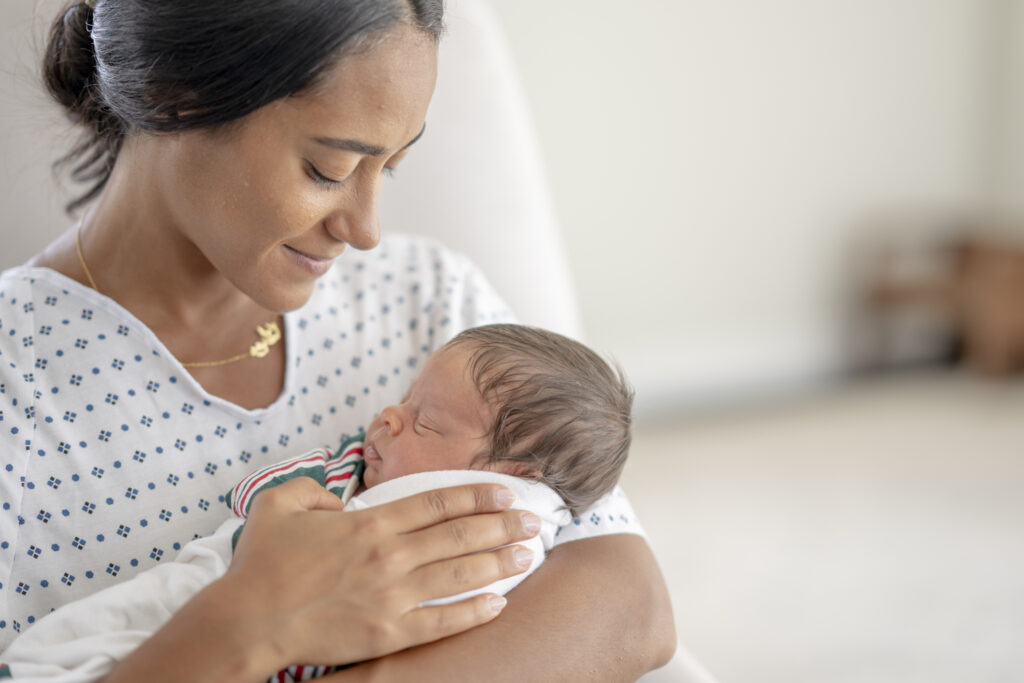In September, state officials gathered in Seattle for the National Academy for State Health Policy’s (NASHP) 35th annual conference. With a focus on decreasing racial disparities in maternal mortality, states participating in a NASHP policy academy met to learn from leading states, share successes, and challenges.
Conference attendees also had the opportunity to hear about key initiatives in California, New Jersey, and Wisconsin to support pregnant and parenting people at the session, No Belaboring the Point: Advancing Equitable Perinatal Health Policy. States identified postpartum coverage, support for people with substance use disorder (SUD), Medicaid coverage of doula services, and payment policies as critical policy levers to address maternal mortality. Download the slides from this presentation (PDF).
New Data on Maternal Mortality Released
The Centers for Disease Control and Prevention (CDC) released a report analyzing pregnancy-related deaths from 36 state maternal mortality review committees from 2017-2019. The report found over 84 percent of pregnancy-related deaths to be preventable, with the majority (53 percent) occurring 7-365 days postpartum. Disparities in maternal mortality also did not improve, with Black individuals more likely to die from pregnancy-related causes. These new data, coupled with recent federal action including a Maternity Care Action Plan by the Centers for Medicare & Medicaid Services outlines the importance of policy intervention in the perinatal period.
Extending Coverage for Continuous Postpartum Care
As of October 2022, 26 states and Washington, DC have extended Medicaid postpartum coverage to 12 months. Research indicates an association between expanded postpartum coverage and postpartum service utilization, including contraceptive and behavioral health services. Currently, Medicaid members receive continuous coverage during the postpartum period due to the continuous eligibility requirement under the public health emergency.
At the NASHP conference, New Jersey and Washington discussed their approaches to extending postpartum coverage. New Jersey’s section 1115 demonstration waiver allows individuals to remain continuously enrolled in 12 months of postpartum coverage regardless of income changes. In Washington, 12 months of postpartum coverage was implemented through a state plan amendment (SPA) and is known as After-Pregnancy Coverage (APC). APC is full scope Medicaid coverage and available regardless of the end of pregnancy outcome or immigration status. State officials identified the need to rigorously evaluate the impact of postpartum coverage extension on health outcomes and cost savings for sustainability past the existing 1115 waiver demonstration and American Rescue Plan SPA option, available to states for five years.
Supporting Pregnant and Parenting People with Substance Use Disorder
Mental health and SUD account for over 22 percent of pregnancy-related deaths, and are leading causes of maternal mortality in many states. Meeting the needs of pregnant and parenting people with SUD requires comprehensive SUD treatment and care coordination to meet other health-related social needs.
To learn more about state models to address SUD for pregnant and parenting people, read NASHP’s brief, State Options for Promoting Recovery among Pregnant and Parenting Women with Opioid or Substance Use Disorder.
In Washington, a 2019 legislative report identified an increase in the number of infants born with neonatal abstinence syndrome or neonatal opioid withdrawal syndrome (NAS/NOWS). Pregnant and postpartum people with SUD are a priority population for the Washington Health Care Authority. A recommendation from the 2019 report included reimbursement of nonpharmacologic first-line treatment. Eat, Sleep, Console is an evidence based best practice involving evaluating an infant’s ability to eat, sleep and be consoled, and intervening with skin-to-skin contact, frequent feeding, and soft environments if needed. Several studies show the hospital length of stay for infants with NAS/NOWS decreases to 5-6 days with this intervention. As parents are generally discharged 24-48 hours post-delivery, the reimbursement allows the parent to ‘room in’ with the infant. Hospitals are reimbursed with an administrative day rate for the birthing parent to remain inpatient after discharge. The day rate is available up to five days with additional time available through prior authorization.
The Eat, Sleep, Console administration rate is billed with the Washington Health Care Authority Medicaid revenue code 0191 as an administration day rate under the birthing parent’s identification number, and the International Classification of Disease (ICD)-10 diagnosis code 099.320 (drug use complicated pregnancy). The reimbursement daily rate is $293.16 as of November 2021.
Indiana is participating in the Center for Medicare and Medicaid Innovation (CMMI) Maternal Opioid Misuse (MOM) model to coordinate care and remove barriers for pregnant and postpartum people with OUD. The goals of the Pregnancy Promise Program include improving access to prenatal care, opioid treatment and recovery services, and identifying and referring participants for health-related social needs. Participants are matched with a case manager for the length of the program, through 12 months postpartum. To date, nearly 300 pregnant people have been enrolled in the program across 68 counties.
Covering Doula and Midwifery Services for Medicaid Members to Improve Outcomes
State leaders recognize the need to support and expand a diverse perinatal workforce to meet the needs of pregnant people. States are increasingly interested in launching pilot projects and implementing Medicaid coverage for doula and midwifery services, as evidence shows continuous support during childbirth leads to positive birth outcomes for the parent-infant dyad. State leaders discussed the importance of working with the provider community, especially providers from historically marginalized backgrounds, during benefit design.
New Jersey provided an update about its Medicaid doula benefit that began in 2021. Currently, all five of the state’s Medicaid managed care organizations contract with enrolled doulas and are actively recruiting doulas. As of August 2022, 56 community doulas and four doula agencies are enrolled as Medicaid providers in the state’s Medicaid program, NJ FamilyCare. Doulas have provided services to 57 NJ FamilyCare members and 41 babies have been born with doula support. New Jersey will expand access to certified and certified professional midwives for NJ FamilyCare members. Washington is also increasing access to midwifery-led care for Medicaid enrollees by building awareness, implementing equitable reimbursement policies, and addressing access and contracting barriers for Medicaid members.
To learn more about Medicaid coverage of community health workers (CHWs), doulas and midwives, visit NASHP’s trackers:
California is incorporating community-based providers into maternity care for Medicaid beneficiaries by partnering with community health workers (CHWs) and doulas. In July 2022, the state began reimbursing for services provided by CHWs when recommended by a physician or other licensed practitioner. The Department of Health Care Services (DHCS) added CHW services though a Medicaid SPA. CHWs provide health education, navigation, screening, assessment, and advocacy related to chronic conditions, mental health, substance use disorder, perinatal health conditions, sexual and reproductive health, child health, oral health, domestic violence, and violence prevention.
California is also implementing coverage of doula services scheduled to begin in 2023. DHCS is working closely with the doula community and a third-party facilitator to ensure the benefit addresses providers desires and concerns. Doula services will support the department’s bold goals in their 2022 Comprehensive Quality Strategy to reduce maternal disparities, especially for Black and American Indian/Alaska Native populations.
Paying for Health: Innovative Maternal Health Payment Models
With Medicaid paying for nearly 40 percent of births nationwide, states can leverage innovative payment models for care delivery with a focus on increasing care quality and outcomes and reducing racial and ethnic disparities.
Wisconsin presented on its obstetric medical home (OBMH) program and recent performance improvement projects (PIPs). Wisconsin’s OBMH is a long-standing medical home model within their health maintenance organizations (HMOs). It provides care coordination for pregnant women with a previous poor birth outcome, a chronic behavioral and/or medical condition, who are under 18 years old, experiencing homelessness and/or Black/African American. The program is a partnership between the state’s 14 Medicaid HMOs, OBHM clinic sites, and the Division of Public Health. Since inception, the number of OBMH participants has increased to an average of 607 individuals per year. Between 2011 and 2020, the state paid over $10.4 million in incentive payments to participating clinics, and 90 percent of participating women experience positive birth outcomes.
In addition to the OBMH, Wisconsin began PIPs to address racial and ethnic disparities in postpartum care identified through Healthcare Effectiveness Data and Information Set (HEDIS) measures. The PIPs began in 2020, and due to COVID-19, the Department of Health Services chose to implement the program over three years and increase the pay for performance (P4P) withhold over time. Examples of PIP interventions with HMOs and clinics include cultural competence organizational self-assessments, data analysis on social determinants of health (SDOH) needs, partnerships with CBOs to provide health-related social needs, and provider trainings on culturally and linguistically appropriate care. HMOs were required to submit PIP proposals, quarterly progress reports and final reports.
In 2022, New Jersey launched a three-year episode of care pilot to improve perinatal care quality, reduce racial disparities, and promote comprehensive care coordination. The model allows providers to join in shared savings when there is acceptable performance on five quality measures (prenatal depression screening, gestational diabetes, delivery mode (vaginal for low-risk births), postpartum visit within 3 weeks, neonatal visit within 5 days) and reduced expenditures relative to the pre-episode baseline. The pilot also allows additional payments for high performers and providers with a high percentage of patients with SUD.
Washington is also in the design phase of a new maternal care model. The model will likely begin in 2024 and use a value-based purchasing approach.
Conclusion
States have a variety of levers to improve health outcomes and promote health equity for maternal and child health populations. The policies discussed are examples shared by state leaders at NASHP’s annual conference. In some states, initiatives are the result of legislation, or a priority for individual agencies. In other states, like New Jersey, reducing maternal mortality is a gubernatorial priority that involves a multi-agency approach. NASHP will continue to support states in their efforts to advance equitable maternal health policy.
Acknowledgements
This blog is supported by the Health Resources and Services Administration (HRSA) of the US Department of Health and Human Services (HHS) under the Supporting Maternal and Child Health Innovation in States Grant No. U1XMC31658; $398,953. This information, content, and conclusions are those of the authors and should not be construed as the official position or policy of, nor should any endorsements be inferred by HRSA, HHS, or the US Government. The author would like to thank Carrie Hanlon for her feedback and review.




